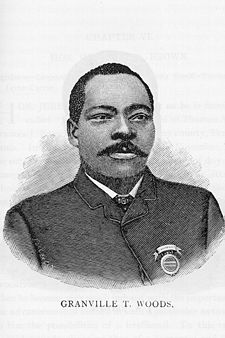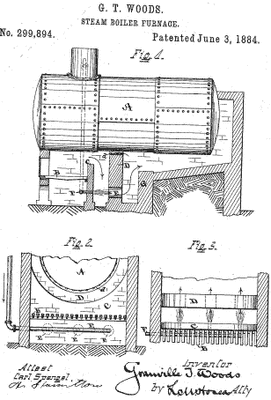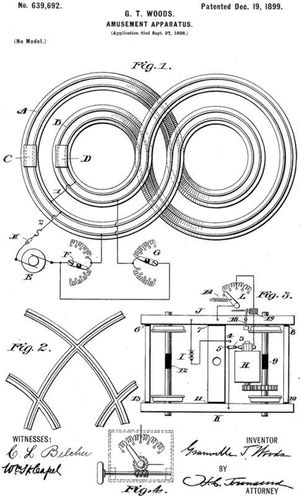Granville T. Woods: Difference between revisions
(New page: == '''Granville T. Woods: Improving Railway Communications''' == <pageby nominor="false" comments="false"></pageby>; Article Content Goes Here... <br> <rating comment="false"> Well W...) |
No edit summary |
||
| (25 intermediate revisions by 4 users not shown) | |||
| Line 1: | Line 1: | ||
== | == Biography == | ||
[[Image:Granville woods.jpg|thumb|right|Granville Woods]] | |||
[[Image:Granvilleinvention2.gif|thumb|right|Wood's Steam Boiler Furnace]] | |||
[[Image:GranvilleWoodsinventions.jpg|thumb|right|Amusement Apparatus]] | |||
Granville T. Woods was born in Columbus, Ohio on 23 April 1856 and was the son of former slaves. He had little formal schooling when he began his career as an inventor, but apprenticed in a machine shop and learned the machinist and blacksmith trades. He then worked in a variety of transportation and industrial jobs while continuing to teach himself about electricity and mechanics, occasionally managing to get tutoring or take night courses in engineering (he eventually earned a degree). | |||
Woods eventually settled in Cincinnati, Ohio, where he turned his attention to inventing. He received his first patent in 1884 for an improved steam boiler furnace. He licensed many subsequent mechanical inventions to the major corporations of the day. | |||
All the while, however, electricity remained his greatest interest. In 1887, he invented what many consider to be his greatest contribution: the Synchronous Multiplex Railway Telegraph, which allowed communications between train stations and moving trains. Train accidents and collisions were causing great concern to both the public and the railways at the time. Woods’ invention, which became universally used, made it possible for trains to communicate with the station and with other trains; every dispatcher and every engineer knew exactly where every train was at all times. This invention made train movements quicker and prevented countless accidents and collisions. Woods continued to invent-- he earned a total of 45 U.S. patents-- until his death in New York on 30 January 1910. Woods is known to many as "The Black Edison," because both were great inventors who came from disadvantaged childhoods. | |||
== Further Reading == | |||
<p>1) Black Inventors in the Age of Segregation: Granville T. Woods, [[Lewis Latimer: An Edison Pioneer|Lewis H. Latimer]], and Shelby J. Davidson. </p> | |||
<p>Rayvon Fouche. Baltimore, Maryland: The Johns Hopkins University Press, 2003. </p> | |||
[[Category:People and organizations|Woods]] [[Category:Inventors|Woods]] [[Category:African-American pioneers|Woods]] [[Category:Communications|Woods]] [[Category:Telegraphy|Woods]] [[Category:Transportation|Woods]] [[Category:Land transportation|Woods]] [[Category:Rail transportation|Woods]] [[Category:Power, energy & industry application|Woods]] [[Category:Electromechanical systems|Woods]] [[Category:Furnaces|Woods]] | |||
</ | |||
</ | |||
Revision as of 18:47, 18 January 2012
Biography
Granville T. Woods was born in Columbus, Ohio on 23 April 1856 and was the son of former slaves. He had little formal schooling when he began his career as an inventor, but apprenticed in a machine shop and learned the machinist and blacksmith trades. He then worked in a variety of transportation and industrial jobs while continuing to teach himself about electricity and mechanics, occasionally managing to get tutoring or take night courses in engineering (he eventually earned a degree).
Woods eventually settled in Cincinnati, Ohio, where he turned his attention to inventing. He received his first patent in 1884 for an improved steam boiler furnace. He licensed many subsequent mechanical inventions to the major corporations of the day.
All the while, however, electricity remained his greatest interest. In 1887, he invented what many consider to be his greatest contribution: the Synchronous Multiplex Railway Telegraph, which allowed communications between train stations and moving trains. Train accidents and collisions were causing great concern to both the public and the railways at the time. Woods’ invention, which became universally used, made it possible for trains to communicate with the station and with other trains; every dispatcher and every engineer knew exactly where every train was at all times. This invention made train movements quicker and prevented countless accidents and collisions. Woods continued to invent-- he earned a total of 45 U.S. patents-- until his death in New York on 30 January 1910. Woods is known to many as "The Black Edison," because both were great inventors who came from disadvantaged childhoods.
Further Reading
1) Black Inventors in the Age of Segregation: Granville T. Woods, Lewis H. Latimer, and Shelby J. Davidson.
Rayvon Fouche. Baltimore, Maryland: The Johns Hopkins University Press, 2003.


